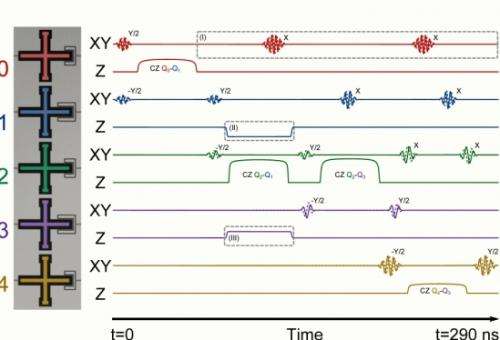
- #QUANTUM ERROR CORRECTION WITH SUPERCONDUCTING QUBITS HOW TO#
- #QUANTUM ERROR CORRECTION WITH SUPERCONDUCTING QUBITS FULL#
- #QUANTUM ERROR CORRECTION WITH SUPERCONDUCTING QUBITS CODE#
A combination of improved accuracy and rigorous error correction could eventually realize the dream of practical quantum computers.

#QUANTUM ERROR CORRECTION WITH SUPERCONDUCTING QUBITS HOW TO#
But the UCSB researchers want to show how to correct for natural errors that arise in the course of real quantum-computing operations. Previously, researchers showed how to correct big errors that were deliberately injected into quantum-computing arrays. The next step for the UCSB team is to run simple error-correction experiments-a huge first for the quantum-computing field. “But what you’ll have to come up with is the wiring and control done in a 2-D system without hampering the fidelity.” “The physics of coupling and control is not going to change,” says Rami Barends, a postdoctoral fellow in physics at UCSB. The idea of connecting thousands of qubits without causing interference among neighboring qubits also presents a huge engineering challenge, though one that doesn’t run afoul of any physics. Still, researchers must continue to improve accuracy rates before they can achieve highly reliable quantum computations, which may still require 1000 or even 10 000 physical qubits to encode a single logical qubit. Improved accuracy for superconducting qubits makes the technology a serious rival of other quantum-computer systems, such as the use of trapped ions as qubits. Watson Research Center, in Yorktown Heights, N.Y.

“Both our result and the one from UCSB are showing the promise for superconducting qubits, and that architectural and engineering challenges lie ahead of us and should begin to be addressed to get toward a fault-tolerant quantum computer,” says Jerry Chow, a research staff member at IBM’s Thomas J. In research posted online to the arXiv repository last November, one IBM group demonstrated a smaller three-qubit system capable of running surface code, although that system had a lower accuracy-94 percent. IBM researchers have also done pioneering work in making surface-code error correction work with superconducting qubits.
#QUANTUM ERROR CORRECTION WITH SUPERCONDUCTING QUBITS CODE#
In this setup, the surface code can indirectly measure possible errors in the data qubits without disturbing their delicate quantum states. The qubits would be arranged in a checkerboard pattern where “white squares” would hold data qubits for performing operations and “black squares” would contain measurement qubits that detect and correct errors in the neighboring data qubits.
#QUANTUM ERROR CORRECTION WITH SUPERCONDUCTING QUBITS FULL#
The USCB team’s success with using surface code on a linear array of qubits could lead to a full 2-D grid of qubits capable of making important calculations. “The surface code tolerates a lot of error and doesn’t ask much from the hardware,” says Austin Fowler, a staff scientist at UCSB who also worked on the quantum error-correction device. The qubits themselves are Josephson junctions-two layers of superconductor separated by a thin insulating layer.īy creating an arrangement of five qubits in a line, the researchers showed that they could perform the logic operations at the heart of modern computing with an accuracy of 99.92 percent for a quantum logic gate involving one qubit and 99.4 percent for a quantum logic gate involving two qubits. Martinis and his colleagues used superconducting quantum circuits that represent one of several possible hardware architectures for quantum-computing systems.

“We made a significant advance in the fidelity that brought it to this important limit, and we did it in such a way that we know how we’re going to scale up to more and more qubits,” says one of the prototype’s creators, John Martinis, a professor of physics at the University of California, Santa Barbara. An experimental system detailed recently in Nature demonstrated the first surface-code architecture to achieve that needed 99 percent accuracy. But one method, known as surface code, can get away with a lower accuracy threshold of 99 percent by shifting much more of the scheme’s complexity to the classical processing. Most quantum error-correction schemes involve very simple classical processing but require quantum logic operations with an accuracy of more than 99.999 percent.


 0 kommentar(er)
0 kommentar(er)
